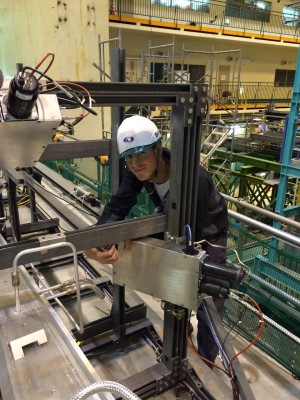They follow the sun: the CAST experiment at CERN.
The CAST project’s magnet – a former test magnet from the LHC – is equipped with an X-ray telescope and X-ray detectors at either end. It starts its day job 45 minutes before sunrise and follows the sun until the limits of the building are reached (1.5 hours later). It starts working again around sunset, when the sun comes back into reach. Its aim: to find axions, hypothetical particles that may be produced in huge amounts in the centre of the sun.
Axions are a candidate for dark matter and could also explain why the strong interaction doesn’t show signs of a physical imbalance called CP violation, whereas the weak interaction does. If found, axions would be a revolution in physics, but so far they have been hiding very well. Scientists think that they are extremely light particles and that they hardly interact with normal matter.
Theory predicts that axions are produced when a photon converts into an axion in a large electromagnetic field. Both photons and such a field exist in the centre of the sun, so CAST researchers concluded two things: not only must axions be produced in the sun, but the process could also be reversed if the axion hits another large electromagnetic field. In the centre of the LHC magnet it should thus be possible to convert an axion back into a photon and detect the photon as it travels through the magnet.
While CAST has narrowed down the possibilities for axion production in the sun, it hasn’t found any direct evidence yet. Recently, even more exotic particles called solar chameleons were added to the CAST search list, and this is where ILC detector R&D comes in. Solar chameleons are predicted to have much lower energy, so a detector that can spot low-energy X-rays with very little background irritation was needed. “The InGrid detector our collaboration has advanced for the ILD TPC sounded like just the right thing,” says Klaus Desch from the University of Bonn. “We needed to equip it for operation in the vacuum of the X-ray telescope, but after initial hiccups an InGrid detector started taking data in autumn 2014.” The team will look at the data when they are sure to understand the busy background well enough to spot what they are looking for.

Frank Simon from MPI Munich installing the CLAWS detector in the Belle detector hall. Image: MPI Munich
Another example of linear collider tech used in a running experiment comes from the calorimeters. In fact, it’s two examples: when the Belle II detector at the SuperKEKB accelerator at KEK in Japan goes online in a couple of years, it will use the ILC-candidate pixel sensor DEPFET for its vertex detector.
But before Belle II starts operation, another detector will takes its place to understand the background radiation from the beam so that Belle II results will not be affected by it. This commissioning detector – a bulwark against the heavily increased intensity of the upgraded accelerator – is appropriately called BEAST II.
And the CLAWS of the BEAST come from the linear collider world, from the CALICE collaboration to be precise. CLAWS stands for sCintillation Light And Waveform Sensors and consists of scintillators, SiPMs, normally used to study the hadronic showers in a calorimeter (see this week’s other story), and popular because of their time resolution. In the first phase of SuperKEKB commissioning, to begin in early 2016, CLAWS will re-use eight small scintillator tiles that already have been used in CALICE detector prototypes to measure the time structure of hadronic showers over long timescales of several microseconds, a sub-experiment called T3B (Tungsten Timing TestBeam). In BEAST II, CLAWS will measure how the background evolves over time after the injection of new electrons or positrons by continuously monitoring particle rates over many turns around the ring. This requires a time resolution of about one nanosecond to reliably tell individual particle bunches apart, and continuous readout for hundreds of microseconds – a capability that these scintillator tiles together with a specialised readout system can provide. The information from CLAWS will be particularly useful for the future vertex detector that needs to tell individual events apart and could be confused by beam background.
CLAWS is being installed this week, so stay tuned for more news from the beast…

Recent Comments